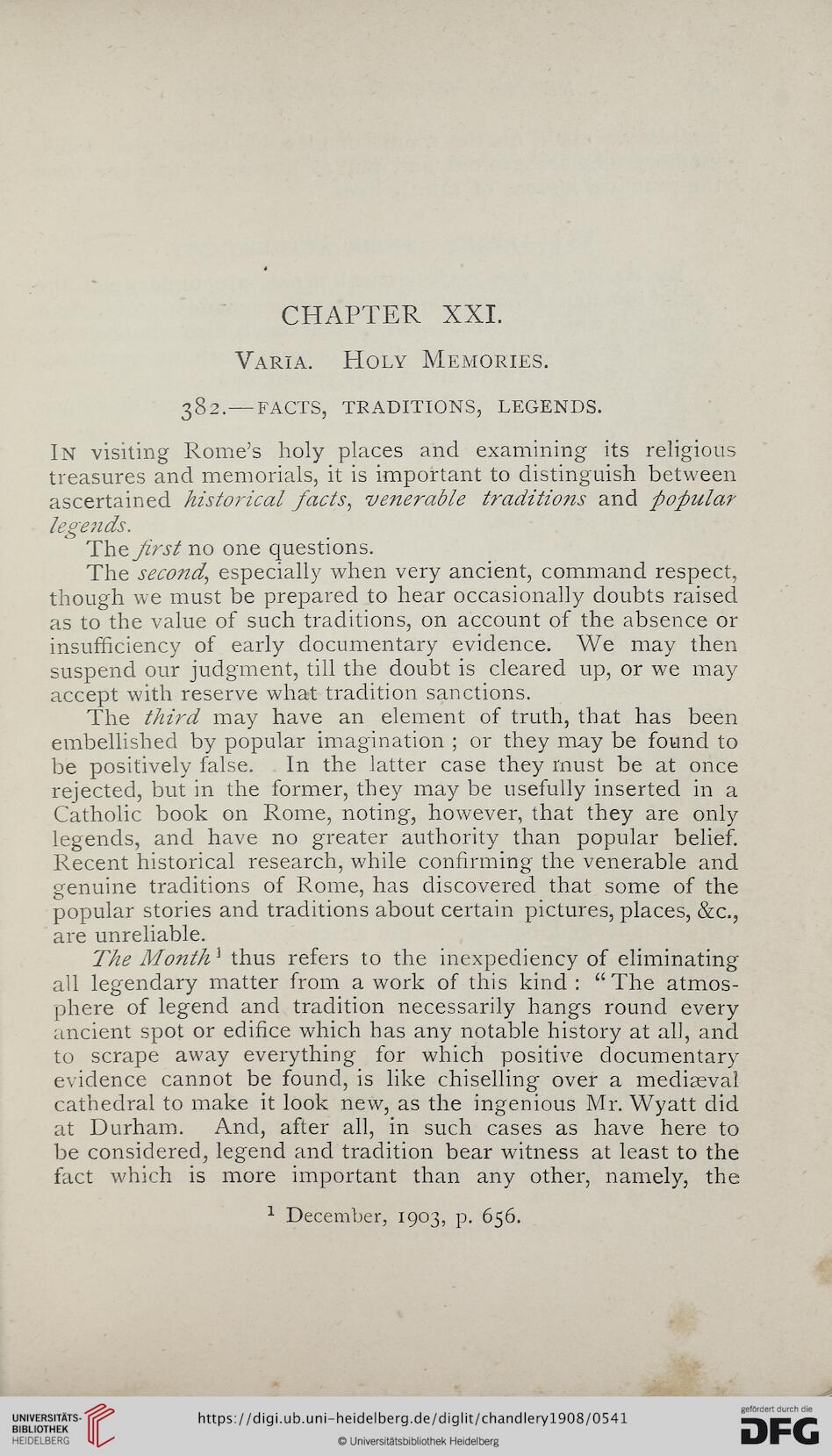CHAPTER XXI.
Varia. Holy Memories.
382. — FACTS, TRADITIONS, LEGENDS.
IN visiting Rome’s holy places and examining its religious
treasures and memorials, it is important to distinguish between
ascertained historical facts, venerable traditions and popular
legends.
The first no one questions.
The second, especially when very ancient, command respect,
though we must be prepared to hear occasionally doubts raised
as to the value of such traditions, on account of the absence or
insufficiency of early documentary evidence. We may then
suspend our judgment, till the doubt is cleared up, or we may
accept with reserve what tradition sanctions.
The third may have an element of truth, that has been
embellished by popular imagination ; or they may be found to
be positively false. In the latter case they must be at once
rejected, but in the former, they may be usefully inserted in a
Catholic book on Rome, noting, however, that they are only
legends, and have no greater authority than popular belief.
Recent historical research, while confirming the venerable and
genuine traditions of Rome, has discovered that some of the
popular stories and traditions about certain pictures, places, &c.,
are unreliable.
The Month1 thus refers to the inexpediency of eliminating
all legendary matter from a work of this kind : “ The atmos-
phere of legend and tradition necessarily hangs round every
ancient spot or edifice which has any notable history at all, and
to scrape away everything for which positive documentary
evidence cannot be found, is like chiselling over a mediaeval
cathedral to make it look new, as the ingenious Mr. Wyatt did
at Durham. And, after all, in such cases as have here to
be considered, legend and tradition bear witness at least to the
fact which is more important than any other, namely, the
1 December, 1903, p. 656.
Varia. Holy Memories.
382. — FACTS, TRADITIONS, LEGENDS.
IN visiting Rome’s holy places and examining its religious
treasures and memorials, it is important to distinguish between
ascertained historical facts, venerable traditions and popular
legends.
The first no one questions.
The second, especially when very ancient, command respect,
though we must be prepared to hear occasionally doubts raised
as to the value of such traditions, on account of the absence or
insufficiency of early documentary evidence. We may then
suspend our judgment, till the doubt is cleared up, or we may
accept with reserve what tradition sanctions.
The third may have an element of truth, that has been
embellished by popular imagination ; or they may be found to
be positively false. In the latter case they must be at once
rejected, but in the former, they may be usefully inserted in a
Catholic book on Rome, noting, however, that they are only
legends, and have no greater authority than popular belief.
Recent historical research, while confirming the venerable and
genuine traditions of Rome, has discovered that some of the
popular stories and traditions about certain pictures, places, &c.,
are unreliable.
The Month1 thus refers to the inexpediency of eliminating
all legendary matter from a work of this kind : “ The atmos-
phere of legend and tradition necessarily hangs round every
ancient spot or edifice which has any notable history at all, and
to scrape away everything for which positive documentary
evidence cannot be found, is like chiselling over a mediaeval
cathedral to make it look new, as the ingenious Mr. Wyatt did
at Durham. And, after all, in such cases as have here to
be considered, legend and tradition bear witness at least to the
fact which is more important than any other, namely, the
1 December, 1903, p. 656.




